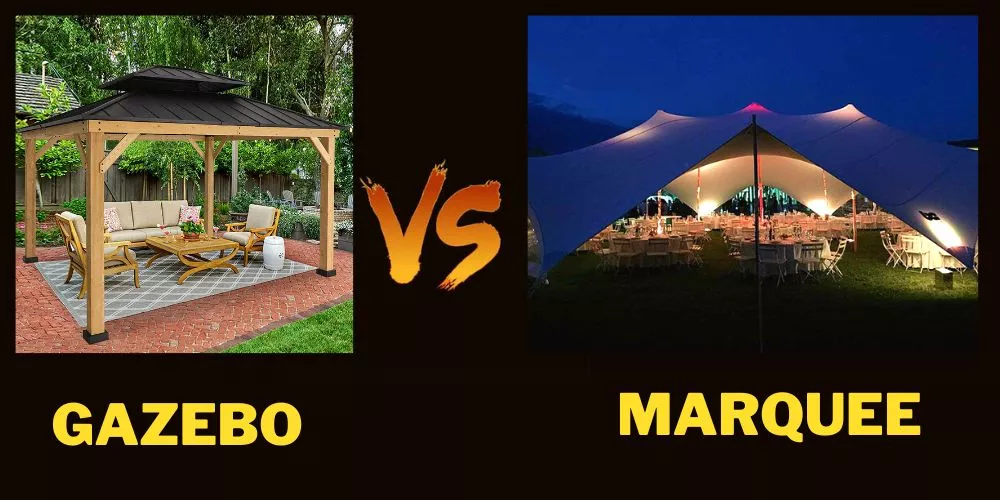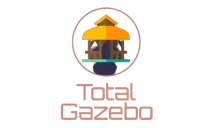Gazebos and marquees are extremely popular structures that can be used for shelter and aesthetics. They are often set up for outdoor activities or events such as camping, sports days, weddings, business meets, etc. In most cases, they can help protect from rain, sun, and wind. However, some slight differences between the two make them easily distinguishable.
For example, in their portable form, gazebos are much smaller and more flimsy. Marquesses are quite the opposite in that they are larger and sturdy. But that’s just scratching the surface. In this article, we’ll look at gazebo vs marquee comparison in detail.

What is a Gazebo?
A traditional gazebo was designed and created as a smaller, more intimate structure placed in a park or garden. The shape would vary between hexagon and octagon (6 to 8 sides) or even square. They would usually contain a bench and be used as a sitting area.
They contained a shingled roof, often manufactured using asphalt, wood, or plastic composites. Depending on their intended usage, they could have been built with side railings or walls.
Fast forward to today; you still see these types of structures, only they use updated materials. Furthermore, hybrid portable or pop up variants have also been created so that shelter can be added to improve the quality of outdoor activity or experience. These versions can be erected and dismantled relatively easily and constructed using lightweight materials such as plastic composites and aluminum.
What is a Marquee?
The marquee also has its traditional roots, which were used to shelter much larger crowds for events such as feasts, weddings, parties, etc. They were and still are built in smaller sections and carefully stitched together to create a large undercover area.
They are usually rectangular and have large, draping wall sections to offer sideways respite from any winds, rain, or snow. The main supports consist of at least 2 King poles which are set in place on the inside.
The canvas based material is carefully attached to these poles and held outwards by a series of highly strung guy ropes. Marquees today are also supported by an inner skeleton type system that helps form the walls at the base of the roof’s pitch. Otherwise, the covering material would stretch from the king poles’ tip to the ground. Marquees are popular today because of their rustic elegance, with a hint of vintage appeal.
Gazebo vs Marquee: Comparison
Gazebos and marquees are quite similar in the way that they are structured. Especially in the more modern versions, hence why they are often confused. They are both great alternatives for shelter; however, choosing between the two will largely depend on the number of users it will have. Let’s have a look at both of the options head to head.
Magnitude/Size
Gazebos are generally much smaller, and their construction isn’t as intricate. The most common types range from 8 ft x 8 ft (2.5 m x 2.5 m) to around 13 ft x 20 ft (4 m x 6 m). They can usually be packed into a handy carry bag for easy transport. Most of the newer versions simply unpack and pop up. You may need to lock in a few pieces and clip on some side walls, but they are generally easy for one person to manage.
Marquees are usually much, much larger. They are built for big events, so the overall structure must be quite robust. The sizes of a marquee range from 12 ft x 12 ft (3.6 m x 3. 6m) which suits approximately 10 standing guests, to around 30 ft x 90 ft (9 m x 27 m) which can comfortably shelter 400 people.
Comfort
The comfort of any of the 2 options largely depends on the designer. For example, gazebos can be decked out on a camping trip with padded flooring, drop down walls, lounge chairs, candles, plants, etc. This can be amazingly comfortable because it’s intimate and personal.
The larger floor space of a marquee can also be transformed into a haven of comfort. The only difference is that you would likely need many more items to achieve the level of comfort required in such a large space.
You could even add a central stove or another heating option, allowing guests a comfort level that gazebos can’t. Heating a gazebo is possible, but the safety aspect must be respected. The lower roof may not allow such heaters. In this case, leaving one side open to a campfire can be a great alternative.
Space
Simply put, gazebos don’t generally have a large footprint when it comes to setup. They can usually be erected anywhere with around a 20 ft x 20 ft (6 m x 6 m) ground area. They are a great option for beach days, camping, sports events, etc., where other people may do the same thing in that area. The often straight shape of a gazebo allows it to be put up in a line alongside others so the overall space used can be minimized.
Whereas a marquee can be built for huge events, therefore they have much more space to work with, meaning they require a much larger area to build on. These modulated shelters can house anywhere up to 400 people. Even then, they can be connected to another 400 person marquee, and the size starts to blow out.
Purpose
In the traditional sense, Gazebos were used as garden or park sitting areas. These were more permanent structures. They were built on the spot with longevity in mind. These days, the gazebo has been transformed into more of a hybrid from where it can be easily packed down and transported to wherever the owner desires.
They can be used anywhere that needs shelter from rain and sun. The overall strength may not handle too heavy winds, but that all depends on the quality and method of stabilization. Some common uses include camping trips, sales tents for markets, beach trips, smaller parties, etc.
A marquee is designed for larger groups that attend events such as music, food, or sports festivals, as well as weddings and/or business functions.
Cost
A basic traditionally built gazebo can cost between $5,000-$10,000. Of course, you can go all fancy and customize them, which may see you pay somewhere north of $20,000 or so. It all depends on what your budget and tastes are. Portable or pop up gazebos can range from $50 to $600; again, budget and style will drive the price to where it should naturally sit.
Marquees, on the other hand, will fetch a much higher price due to their size and the quality of materials used to construct them. You can rent a fully equipped wedding marquee for around $3,500, but that won’t include any extras such as bars, toilets, generators, lighting, heating, dance floor, etc. When purchasing a marquee, you may pay $5,000 or so for a basic one and anywhere up to $40,000 for a huge, fully equipped variant.
Interior
Given that the interior of a gazebo is a lot smaller, there is naturally less room for users to enjoy and decorate. This makes them a great option for personal use.
The interior of a marquee can be quite sizable. It could contain a stage for music, a dancefloor, a bar, heating, lighting, toilets, etc. Many different combinations can be added to a space as large as a marquee.
You May Also Find Useful: Hardtop vs Soft Top Gazebo | Gazebo vs Pavilion
Frequently Asked Questions (FAQs)
Is a marquee a gazebo?
Marquees and gazebos are slightly similar; however, the size and construction can make them easier to distinguish. Marquees are generally much larger, requiring heavy-duty materials and sometimes extra equipment to construct. At the same time, a gazebo is usually portable. Therefore its materials may not need to be as good quality, and they may only require a single person to erect.
What is a small marquee called?
Smaller marquee types include the clearspan or frame variants. They don’t require guy ropes or fixings and offer more inner space due to how they are constructed.
Conclusion:
We have discovered that there are quite a few differences, if we look at gazebo vs marquee comparison. The potential size and a traditional structure are the easiest clues to help distinguish between them. We hope this article has been as enjoyable to read as we had to piece it together. We look forward to seeing you at the next one!
